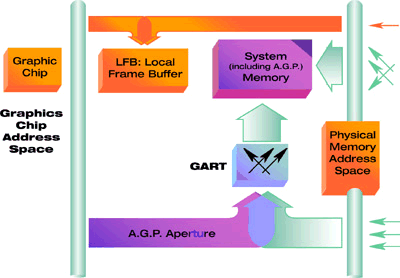|
|
|
|
|
|
|
|
|
|
Chapter 4: AGP Memory Mapping  The processor "linear" virtual addresses are translated by its paging hardware into physical addresses. These physical addresses are used to access system memory, the local frame buffer, and AGP memory. The CPU accesses to the local frame buffer and AGP memory use the same addresses as the graphics controller does. The operating system therefore sets up the CPU paging hardware to a straight 1:1 non-translation of virtual to physical address. For accesses to AGP memory, the graphics controller and CPU use a contiguous aperture of several megabytes. But the GART translates these to various, possibly disjointed, 4 KByte page addresses in system memory. PCI devices that access to the AGP memory aperture (for example, for live video capture) also go through the GART. |
Legal Information © 1997 Intel Corporation